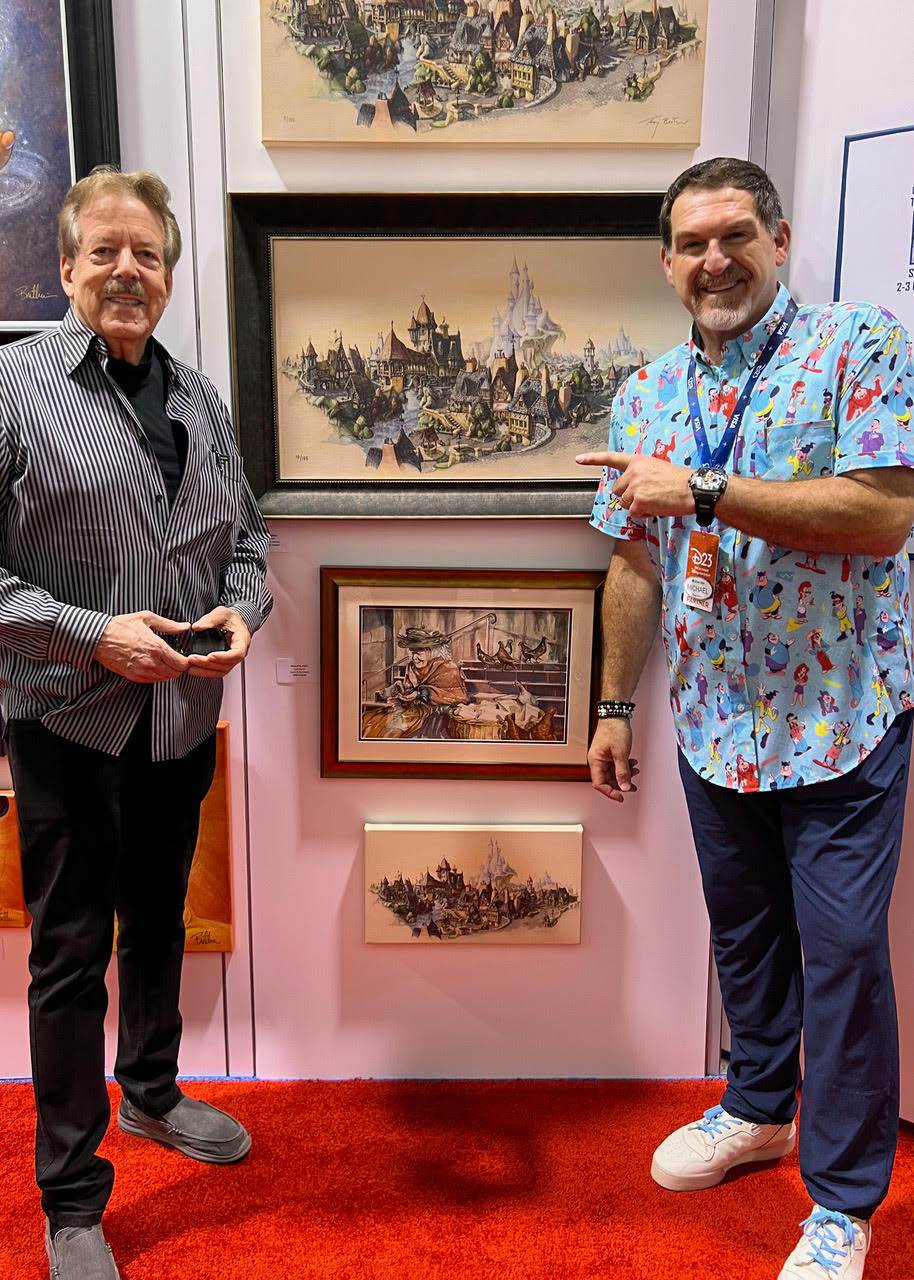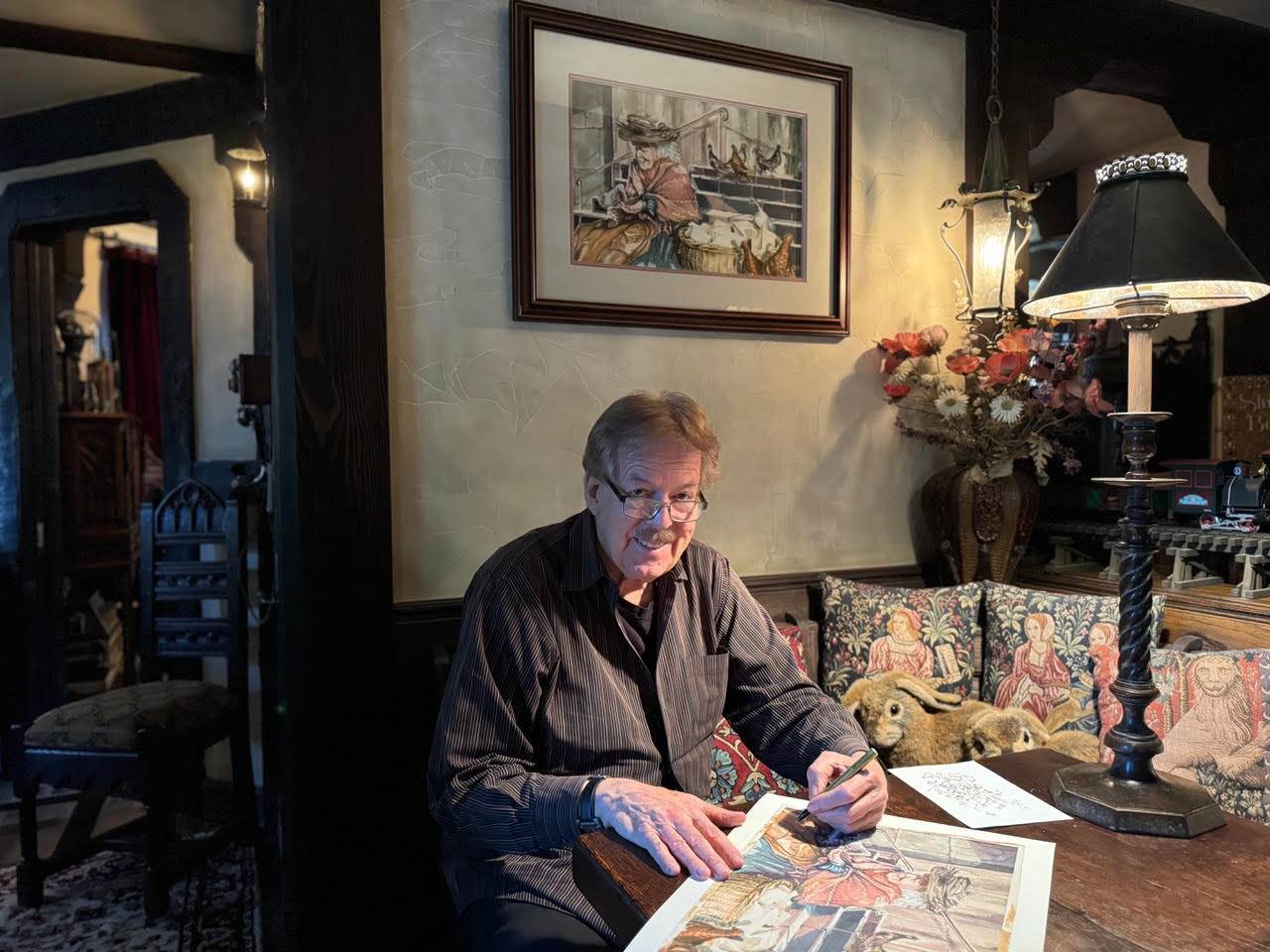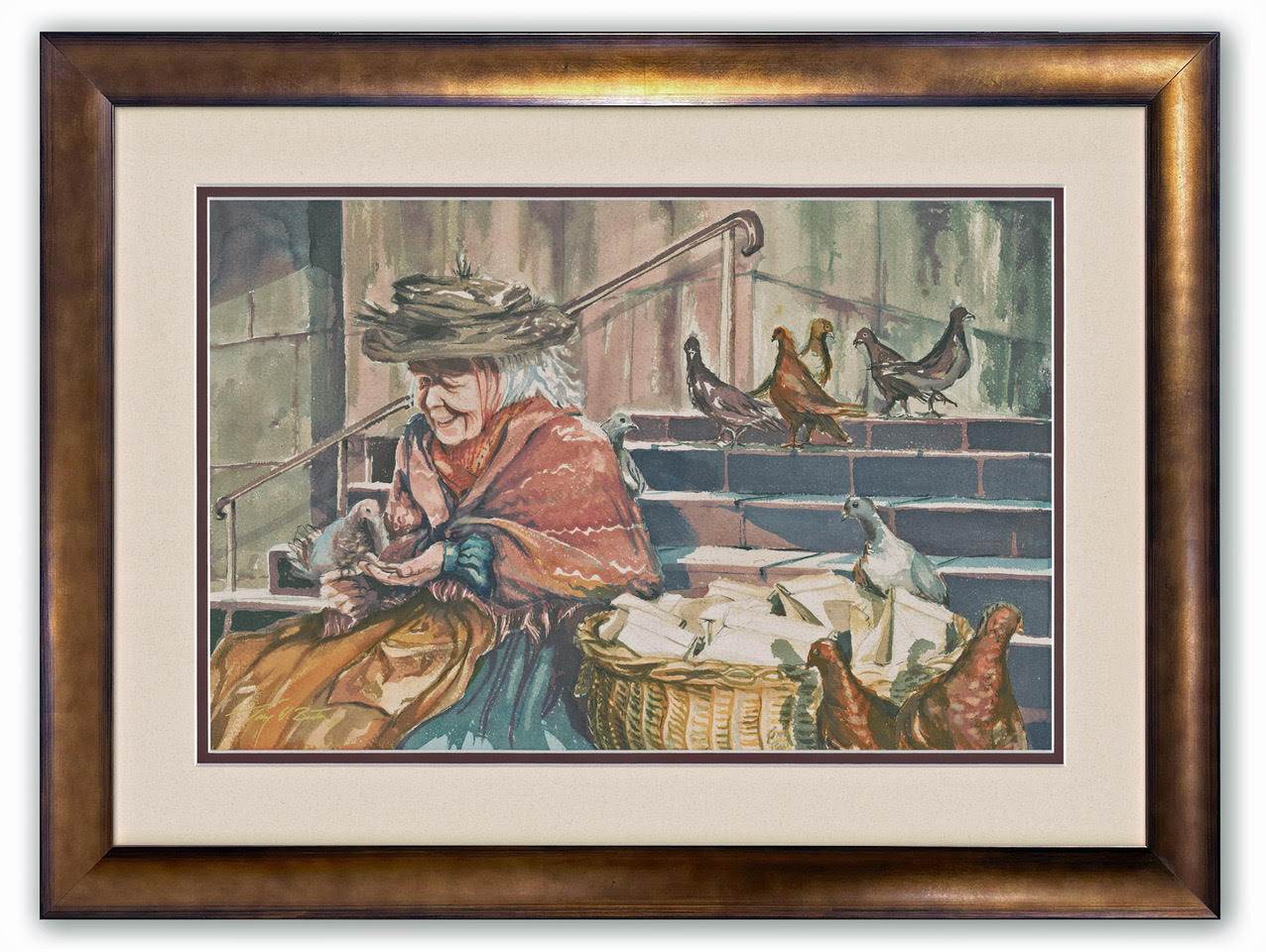Exclusive: Disney Legend Tony Baxter Discusses His Love of “Mary Poppins” and Latest Disney Fine Art Release in New Interview
Tony Baxter is a Disney Legend in the truest sense of the term. Every day, Disney Parks guests can experience some of the classic attractions he’s had a hand in bringing to life. Now, those guests will also have a chance to display a different type of Baxter’s work in their homes.
Disney Fine Art has debuted a new limited edition art piece from Baxter titled “Steps of St. Paul’s." The work was inspired by the iconic “Feed the Birds" segment in Mary Poppins — a film which is celebrating its 60th anniversary. Signed and numbered reproductions of the painting are now available from Disney Fine Arts.
Recently, Michael Young (CEO of Disney Fine Art, published by Collectors Editions and officially licensed by Disney) visited Baxter at his home during a signing session for the new art release. During their conversation, Baxter discussed how this artwork came to be, the impact Mary Poppins has had on his life, and much more.
Michael Young: Tony, please tell us how this beautiful imagery, which you originally conceived many years ago and which we now call “Steps of St. Paul’s," came into being.
Tony Baxter: As a young college student at Cal Poly in Pomona interested in landscape architecture and architectural studies, I received some input and guidance from the HR people at Walt Disney Studios regarding my career. If I wanted to pursue a career with Disney, my career path was veering toward WED Enterprises, now Walt Disney Imagineering, or Walt Disney Feature Animation. The film I suggested for consideration by the animation department was the classic book Charlotte's Web, but that idea wasn’t as enthusiastically received as I had hoped, so my attention turned to WED.
Young: That’s a sharp turn from landscape architecture and architectural design to theater design. How did that come about?
Baxter: After three years, I took a mid-course correction to take more art classes. So, I changed schools from architecture at Cal Poly to theater design at California State University in Long Beach. In the late 1960s, I was partnered with Professor Maxine Merlino, who would become the Dean of the School of Fine Arts and who became my lifetime mentor.
Professor Merlino, who lived to be 101 years old, was very aware that if a project stimulated a student, they would put more into it, so she was quite flexible with me, not making me do assignments but figuring out what I wanted to do and how to do it better.
Young: No pun intended, but this was your first brush attempting to be a painter.
Baxter: Yes. My first class with her was watercolors, and this piece we now call “Steps of St. Paul’s" I did in that class. Walt Disney’s film Mary Poppins had blown my mind five years before, and it was the best film I'd ever seen. The most poignant song in the movie is called “Feed the Birds." I agree with Walt Disney; it is a fantastic piece of music. And, of course, I didn't know the Sherman Brothers personally then, as I would later in life.
So, there I was, a typical fan, but Dr. Merlino, as my teacher, realized that if I can get him excited to do something he loves, he will put much more effort into it. That’s how this piece of art was undertaken.
Young: So, was it a college assignment?
Baxter: It's not an assignment. It was, again, developing my watercolor skills. Because watercolor is precisely the opposite of working with opaque paint, where you're adding color, you're subtracting light in the case of watercolors.
You've got white there already, so you can add darker colors but can’t add white. You only subtract from the brightness of the paper. So, you have to leave the white there. However, in opaque painting, whether acrylic or oil, you can put any color on top. It's a backward process.
Young: It sounds challenging. Did you study any other works to help figure out the watercolor process?
Baxter: I studied Walt Disney’s animated feature Snow White and the Seven Dwarfs. In the wishing well scene near the film's beginning, if you look at that subtle background behind her, the tree branches are white areas of the background paper, and the green around them is the paint, but the stems, twigs, and leaves are all nothing. They're just the white paper showing through. And I just thought that was fascinating!
So, watercolor intrigued me, but it's a do-or-die. There's no going back once you've put color on the paper. In most other media, you can keep adding or overworking it, but you can't do that in watercolor.
Young: But of all the scenes in Mary Poppins why did you choose this one to depict as a piece of artwork?
Baxter: Before getting more refined in my art, I'd done a whole project for Professor Merlino on building a Disneyland attraction based on Mary Poppins. Actually, I didn't do it for her. I did it before taking her class, and I showed it to her, and she said, “Wow! Okay, I see where you're going, and we'll try to develop your skills."
It was done entirely without formal art training, except for taking elective and architecture classes to do this idea for a Mary Poppins attraction.
Ultimately, I took that attraction project that I had done in college with me to WED, and they liked the layout of it. I had planned for everything, the maintenance areas and the complicated engineering, but it all made sense.
I had people on little carousels, like in the “Jolly Holiday" sequence. They jumped off the carousel and went through the “Jolly Holiday" chalk pavement picture like in the film.
Young: Was the whole attraction centered around the “Jolly Holiday" portion of the film?
Baxter: No. When the chalk pavement image cleared, you were in a cloud above London, looking down like Peter Pan. And then the horses settled down through the kites flying at the very end. And so, you went back down into Cherry Tree Lane through all the kites at the end of the song “Let’s Go Fly a Kite."
We had a “Jolly Holiday" theme for most of the ride, then the finale was “Let’s Go Fly a Kite," and then you rejoined the carousel in Cherry Tree Lane and disembarked. Eventually, the people at WED were impressed with it because it looked like it could work.
Through art school and Maxine Merlino, I reached the level represented in “Steps of St. Paul’s." My traditional art training, layered upon my previous studies in architectural design, made me a little bit more viable or sellable to Imagineering.
Young: How do you feel about having “Steps of St. Paul’s" reproduced as a Disney Fine Art limited edition and knowing it will reside in homes worldwide?
Baxter: It’s a “Wow" moment for me. Especially this year during the 60th anniversary of Mary Poppins. So much happened this year to reignite this. I mean, you know, Richard Sherman (one of the composers of the music and songs in the film) sadly passed away. There was a lot of attention at D23: The Ultimate Disney Fan Event celebrating Richard and his brother Bob’s work. But the zenith of their incredible musical legacy is Mary Poppins.
Within the film, Walt's favorite song, and I think for many of us, was “Feed the Birds." So, here I have this artwork that has, you know, been on my wall all this time, and it seemed like, well, this is a good time to share it with others.

Tony Baxter with Michael Young at D23
Young: In creating this piece and now having it reproduced as part of the Disney Fine Art portfolio, why is Mary Poppins your favorite Disney film?
Baxter: Well, Mary Poppins is my favorite live-action Walt Disney film. For animation, my favorite is Sleepy Beauty. But in Mary Poppins, many elements successfully come together, from the music, choreography, art direction, and performances to the animation and the integration of live-action and animation; it's heartwarming and has a storyline that continually tops itself.
Young: Can you give an example of how the film tops itself?
Baxter: For example, film adaptations of Broadway musicals tend to bring back the number one song or biggest production number for the end of the film. At the film's ending, you sing “Hello, Dolly!" again, reprise “Camelot," or something like that. What really sent me out of the theater on a high note was “Let's Go Fly a Kit." Because you hadn't heard it, they snuck it into the score.
Irwin Kostal, who supervised, arranged, and conducted the film’s score, snuck it in here and there, but it was never played in full glory until the very end. So, it was building an imprint on your mind, but the first time, it was revealed in the film’s last five or six minutes.
It was impressive everyone was confident enough to know they didn’t have to drag out “Spoonful of Sugar" or another great song the audience had already heard. No, they saved a song you've never heard before for the finale that is so upbeat and leaves you walking out of the movie on a high. Nothing like that had ever really been done before.
Young: That was pretty daring and innovative for its time.
Baxter: Yes. The movie version of the hit Broadway musical “My Fair Lady" was released the same year, and that movie's first half is stunning. And then it just starts to creep downhill until you get to the song “I’ve Grown Accustomed to Her Face." Eliza Doolittle hands Professor Higgins his slippers, and the door closes—the end.
Mary Poppins takes you musically and emotionally to the highest point where the family reunites, Mr. Banks gets his job back, and the family is again happy. The symbolic nature of everybody flying a kite to a song that defines the fun and emotion of flying a kite; you can’t get any better than that.
Young: You also loved the 2019 follow-up film Mary Poppins Returns with Emily Blunt, Lin-Manuel Miranda and Dick Van Dyke.
Baxter: I love the second film. I loved how they worked, Richard and Robert's music, and even bits of “Feed the Birds" into the new score. Where can you find a film like “Mary Poppins" that is still so popular and beloved 60 years later? And then to think, 55 years later comes along a love letter to the original in the form of Mary Poppins Returns. That’s truly astonishing.
I also loved how the song “Nowhere to Go But Up" in Mary Poppins Returns filled the same purpose as “Let’s Go Fly a Kite." You thought this film was over. We've seen all the good parts, and then there's Angela Lansbury in the park singing “Nowhere to Go But Up." And I said they did it again! And so, both songs have a powerful feeling for me.
Young: Mary Poppins seems to have left an indelible mark on young Tony Baxter that has continued through all these years.
Baxter: It's been a part of my life for 60 years. When I was growing up, you couldn’t run out and buy the film, stream it, or do any of that. The soundtrack didn’t usually come out on the same day as the film. If you were like me, the best you could get was to take a portable audio tape recorder and record the film’s audio from the tinny loudspeaker box at a drive-in, which I did!
When I did this painting, you couldn't go home and look at your Mary Poppins copy for reference, so I had that audio tape recording. It was a way of capturing those moments so influential to you in the film; you couldn’t just sit on your couch and stream it or pop in a disc or anything.
It was a different world. It was an innocent time. I think that’s why I love the film and the “Steps of St. Paul’s" artwork so much. They represent a particular time in my life and a film we can all revisit and share in its special heart, joy, and entertaining innocence.
"Steps of St. Paul's" by Tony Baxter is now available from Disney Fine Art.


